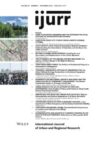This essay is about one street, Lottumstraße, in Berlin, Germany, where my parent and grandparents lived prior to 1940. The current morphology of the street is contrasted with my mother’s experience of life on Lottumstraße during the 1930s. The essay is part of a longer investigation regarding issues of post‐memory as interpreted by the second and third generation of trauma survivors. The essay suggests that, through the act of erasure, traces of the original urban or street condition, and the subsequent urban mark‐making of each successive generation, would be perceived and interpreted in order to authenticate the particulars of place over time. Traces underscore the responsibility to not only remember historic events but to recognize that those events have contemporary political and social implications. The larger scope of the work includes a film production titled ‘TopoNarratives 1‐4’: four short stories based upon specific people and places shaped by the events of the second world war that resonate through subsequent generations across topographies and contemporary political events. The work investigates the relationship of the second generation’s personal construction of place to the public consequence of those private interpretations within the built environment.
Details
Written by:
DIANE FELLOWS
Digital Object Identifier (DOI)
10.1111/j.1468-2427.2009.00932.x
About DOI
Read full article as PDF
Read full article as HTML
See the references for this article
